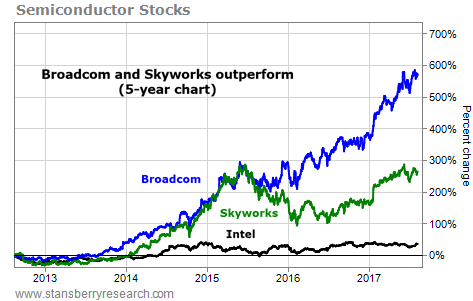You’re looking for a stock with big upside potential…
200%… 500%… maybe more.
This is what you do…
You start by looking for a “game changing” industry trend. Then, you find small- to medium-sized, rapidly growing businesses that are taking part in the trend. And finally, you make sure the company you buy is in a strong financial position.
And today, we’re picking up where we left off…
We’ll dig deeper into why you want to focus your efforts on finding smaller businesses.
And we’ll show you how this process works with recent examples.
Once you see the numbers and charts, we know you’ll see the benefits of our approach…
The Russell 3000 Index includes the largest 3,000 stocks that are traded in the U.S. Its constituents make up about 98% of the market value of all U.S.-based stocks… So it’s often used as a gauge of the entire U.S. stock market.
Last month, we looked at the five-year performance of all the Russell 3000 companies that were larger than $1 billion five years ago. (Some of the businesses that were smaller than $1 billion did soar. But many of them were so volatile, you would have had a hard time holding on to them for long.)
Of those 1,149 companies, 267 (23%) had market values of more than $10 billion, while 882 (77%) had market values of less than $10 billion.
But among the top 100 performers, only 14 had market values of $10 billion or more, while 86 were smaller than $10 billion.
What does this mean?
It means that if you had selected a stock at random from the $10 billion-or-more group, your odds of picking a top 100 performer (after five years) were about one in 20. If you had selected a stock at random from the $1 billion-$10 billion group, your odds of picking a top 100 performer were about one in 10.
In other words, selecting from the group of smaller companies nearly doubled your chance of picking one of the top 100 performers of the past five years. That’s a massive difference.
For an idea of the upper-end gains from this list, media-streaming giant Netflix (NFLX) came in first place. Its shareholders earned 1,536% over five years.
Coming in at No. 100 was labeling and packaging leader Avery Dennison (AVY). It went from a $2.8 billion company in July 2012 to an $8.3 billion company. Its shareholders earned 252% over five years. That’s right… 252%, at the low end of the list.
The message is clear… For the best shot at generating 200%-plus returns, think small.
Now, let’s look at a couple of examples. We’ll go back in time and put ourselves in the shoes of an investor in 2012.
As we mentioned, we start with a big industry trend…
Over the past three decades, the use of semiconductors has skyrocketed. Semiconductors are the little engines that power computers, smartphones, TVs, and lots of other electronic devices. Developments in this industry have changed – and continue to change – the world. It’s a good example because the trend was well established prior to 2012…
According to World Semiconductor Trade Statistics, global semiconductor sales were $33 billion in 1987. By 1997, global sales hit $137 billion. By 2007, they were up to $256 billion. And in 2011, global semiconductor sales reached $300 billion.
You didn’t need to be standing on top of a mountain to see this trend.
If you were looking at semiconductor stocks in 2012, you might have noticed that Intel (INTC), Broadcom (AVGO), and Skyworks Solutions (SWKS) were all doing well. Their market values at the time were $100 billion, $8.3 billion, and $1.1 billion, respectively.
All three companies passed our sales-growth test of 20% per year, on average, for at least two years. And all three were in strong financial positions, with far more cash than debt.
They were all “buys” in 2012… But as you can see in the chart below, the two smaller, rapidly growing businesses have far outperformed Intel over five years…
 Depending on your stop-loss strategy, you might have stopped out of any of these positions in 2015, or you might still be holding shares today. Either way, you likely would have booked at least 200% gains with either Broadcom or Skyworks… and possibly much more.
Depending on your stop-loss strategy, you might have stopped out of any of these positions in 2015, or you might still be holding shares today. Either way, you likely would have booked at least 200% gains with either Broadcom or Skyworks… and possibly much more.
Broadcom and Skyworks are just two examples of our powerful investing strategy at work. We’ve seen many others over the past five years. And we’ll likely see many more in the years ahead.
Now you have the tools you need to find these big opportunities on your own.
Good investing,
Ben Morris and Drew McConnell
[ad#stansberry-ps]
Source: Daily Wealth

